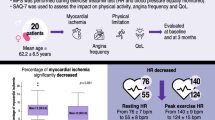Summary
The long term efficacy and safety of Carvedilol, a new vasodilating β-blocking drug, was evaluated in 32 patients with chronic stable angina, using a randomised double-blind, placebo-controlled protocol for 1 month, followed by an open phase of 5 months during which all patients received Carvedilol 25mg twice daily. Treadmill exercise testing was performed at the end of 1 (double-blind), 3 and 6 months (open phase). Five patients were withdrawn from the study, 2 because of adverse events and the rest because of noncompliance or surgical intervention during the study. Exercise time (mean ± SD) had improved significantly on Carvedilol at the end of the double-blind phase (1 month) from 6.6 ± 0.6 to 7.7 ± 0.7 min (p < 0.05) and this was maintained at 3 and 6 months (8.3 ± 0.7 min, p < 0.01 and 8.5 ± 0.7 min, p < 0.005, respectively). In the group started on placebo, exercise time also improved significantly from 6.4 ± 0.5 to 7.3 ± 0.5 min (p < 0.05), but this was further improved at 3 (8.0 ± 0.7 min) and 6 months (8.9 ± 0.8 min) with Carvedilol (p < 0.02 and p < 0.0001, respectively). Time to 1mm ST-segment depression did not alter significantly with placebo (4.8 ± 0.6 to 4.9 ± 0.4 min), but was significantly improved by Carvedilol at 1, 3 and 6 months (p < 0.05, p < 0.01 and p < 0.005, respectively). Similarly, time to development of angina during exercise did not alter with placebo (5.1 ± 0.4 to 5.4 ± 0.4 min), but was significantly increased by Carvedilol at 1 month (5.4 ± 0.4 to 6.3 ±0.6 min, p < 0.02), and this was maintained on long term therapy at 3 and 6 months (6.3 ±0.5 min, p < 0.005, and 6.9 ± 0.5 min, p < 0.001, respectively). Peak exercise heart rate and double product were reduced by active therapy only, at 1 month (124 ± 5 to 107 ± 3 beats/minute, p < 0.0001; 197 ± 11 to 160 ± 9, p < 0.0001), 3 months (108 ± 4, p < 0.0001; 162 ± 9, p < 0.001) and 6 months (108 ± 3, p < 0.0005; 157 ± 7, p < 0.0002), respectively. These results suggest that Carvedilol is a well tolerated and effective β-blocker; however, the lack of any significant difference in exercise time with placebo suggests that the dose of 25mg twice daily is insufficient in the management of chronic stable angina.
Similar content being viewed by others
References
Achenbach C, Nukei B, Weimer J. Effects of vasodilating beta blocker Carvedilol on isolated cardiac tissues (abstract). European Heart Journal 5: 271, 1984
BalaSubramanian V, Bowles MJ, Lahiri A, Davies AB, Raftery EB. Long term anti-anginal action of Verapamil assessed using quantitated serial treadmill stress testing. American Journal of Cardiology 48: 529–535, 1981
BalaSubramanian V, Lahiri A, Paramasivan R, Raftery EB. Verapamil in chronic stable angina. A controlled study with computerized multistage treadmill exercise. Lancet 1: 841–844, 1980
Brown BG, Bolson E, Peterson RB, Pierce CD, Dodge HT. The mechanisms of nitroglycerine action: stenosis vasodilation as a major component of the drug response. Circulation 64: 1089–1097, 1981
Chierchia S, Gallino A, Smith G, Dienfield J, Morgan M, et al. The role of heart rate in the pathophysiology of chronic stable angina. Lancet 2: 1353–1357, 1984
DasGupta P, Broadhurst P, Raftery EB, Lahiri A. Value of Carvedilol in congestive heart failure secondary to coronary artery disease. American Journal of Cardiology 66: 1118–1123, 1990
Ellestad MH, Blomqvist CG, Naughton JP. Standards for adult exercise testing laboratories. Circulation 58: 421A–430A, 1979
Goto Y, Tamachi H, Fusegawa Y, Nakaya N, Homma Y, et al. Effects of Carvedilol on serum lipids in patients with essential hypertension. Journal of Cardiovascular Pharmacology 18 (Suppl. 4): S45–S50, 1991
Grant RHE, Keelan P, Kernohan RJ, Leonard JC, Nancekievill L, et al. Multicentre trial of Propranolol in angina pectoris. American Journal of Cardiology 18: 361–365, 1966
Heber M, Brigden GS, Caruana MP, Lahiri A, Raftery EB. Carvedilol for systemic hypertension. American Journal of Cardiology 59: 400–405, 1987
Kaski JC, Rodriquez-Plaza L, Brown J, Maseri A. Efficacy of Carvedilol (BM 14190), a new beta blocking drug with vasodilating properties, in exercise-induced ischaemia. American Journal of Cardiology 56: 35–40, 1985
Lahiri A, Rodrigues EA, Al-Khawaja I, Raftery EB. Effects of a new vasodilating beta-blocking drug, Carvedilol, on left ventricular function in stable angina pectoris. American Journal of Cardiology 59: 769–774, 1987
Lindrer R, Zahorsky R. Comparison of betablocking, intrinsic and unspecific cardiodepressant activities of different beta-adrenoceptor blocking agents. Abstract. Deutsche Pharmakologische Gesellschaft (Suppl. 1): 322, 1983
Maseri A, Chierchia S, Davies GJ, Fox KA. Variable susceptibility to dynamic coronary obstruction: an elusive link between coronary atherosclerosis and angina pectoris. American Journal of Cardiology 52: 46a–51a, 1983
Opie LH. Basics for cardiovascular therapy with beta-blocking agents. American Journal of Cardiology 52: 2D–9D, 1983
Opie LH. Drugs and the heart. Lancet 1: 693–698, 1980
Prichard BNC. Beta-adrenergic receptor blocking drugs in angina pectoris. Drugs 7: 55–84, 1974
Rodrigues EA, Lahiri A, Hughes LO, Kohli RS, Whittington JR, et al. Antianginal efficacy of Carvedilol, a new beta-blocking drug with vasodilating activity. American Journal of Cardiology 58: 916–921, 1986
Sponer G, Muller-Beckmann B. Studies on the mechanism of the vasodilating activity of BM 14190. Abstract. Deutsche Pharmakologische Gesellschaft (Suppl. 1): 322, 1983
Author information
Authors and Affiliations
Rights and permissions
About this article
Cite this article
DasGupta, P., Jain, D., Lahiri, A. et al. Long Term Efficacy and Safety of Carvedilol, a New β-Blocking Agent with Vasodilating Properties, in Patients with Chronic Ischaemic Heart Disease. Drug Invest 4, 263–272 (1992). https://doi.org/10.1007/BF03258409
Published:
Issue Date:
DOI: https://doi.org/10.1007/BF03258409




